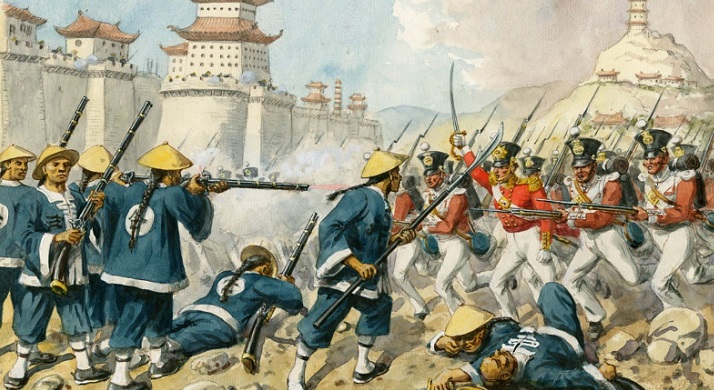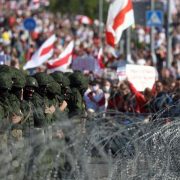
The following are preliminary notes on something that might be important in deciphering some elements of modern China and its clash with the USA. They are about a triangle – a deep connection between how you strategize war, rule your country, and think of the world, i.e., the philosophical tradition. There are differences here between China and Western conventions.
More elements contribute to the difference, for instance, the evolution of logic and what is considered a coherent and convincing argument; the way you portray reality in art; and the way you “forecast” future events, for instance, who will win a war and why. This element is particularly urgent if looking at the present war in Ukraine and Russia’s difficulties there, and China’s possible temptations to slip into a conflict with one of its neighbors.
These are huge topics, and I can’t broach them comprehensively here, but I offer some initial notes on the first “triangle” to help both sides, perhaps to better comprehend some of their friction elements.
Geopolitical Philosophy
In his A History of Chinese Philosophy, Feng Yulan introduced the idea that Greek philosophy was the product of seafarers, who went through the sea, whereas Chinese philosophy was the product of farmers who plowed their plots. So, we had mariners versus farmers, and the two ways of thinking started from these conditions.
Feng’s intuition and explanation still hold and are the root of understanding modern China and Western civilization. Still, almost a century after Mr. Feng first wrote his famous history, it’s time to try to refine this idea and add more substance.
Feng reflected on an idea that later became famous – the fluvial civilization developed by Wittfogel — claiming that managing river waters led to a concentration of power, bureaucracy, and, therefore, highly vertical societies.
Again, this concept has some value but needs to be better tailored because river civilizations happened in very different environments. For instance, the Egyptian and Mesopotamian civilizations started geographically and in time pretty close to one another. However, they seem to be very different from the river civilization of China.
The Egyptian and Mesopotamian civilizations had deserts next to their river basins. They were confined and constrained by the river floods. They had every interest in expanding the beneficial effects of river floods to the adjacent desert to increase the living area for their people.
Besides, the two civilizations were next to two seas. The Sumerian-Babylonians of Mesopotamia were projected to the Indian subcontinent through the Indus River valley on the one hand. On the other hand, they were projected to the Mediterranean Sea. Similarly, the Egyptian civilization was projected to the Mediterranean Sea and, on the other hand, to the rest of Africa and the Red Sea.
Besides, these two civilizations were next to one another, and soon they had interactions, fights, and strife to dominate one another. In the Mediterranean, contact with the Egyptian and Mesopotamian civilizations gave birth to the Minoan civilization from Crete. Crete was then a bridge between Egypt, Mesopotamia, and Greece, which ultimately started what we have as Western civilization.
On the other hand, we had possible contacts with the Sumerian people from the Iranian mountains and the Indus Valley, which may have also triggered the growth of local civilizations. We had a mix of at least two or three main languages that are still with us: the Semitic of ancient Egyptians; the Minoan, a language perhaps wholly lost; and the Indo-European languages from Persia and Greece.
So, there is a world between rivers and seas, which got partially separated later on and developed independently.
The geography of ancient China is very different. In the beginning, we had one river, the Yellow River basin. However, this river is not surrounded by deserts but is encircled by hostile forests. In fact, at the beginning of Chinese civilization, sometime at the end of the second millennium BC and the beginning of the first, China had two concerns: Controlling the water flow from the rivers, its floods, and its river silt. The other was expanding its arable land by clearing fields of forests and their inhabitants: elephants, tigers, and other wild animals.
These two challenges were not what we see in Egypt or Mesopotamia. Besides, the ancient Chinese river valley was fairly isolated from the rest of the cultural exchanges. There were mountains and jungles in the south and southwest, deserts and steppes in the north and northwest, and the sea without large continents and large land masses, except the sparsely populated islands of what is now Japan. It all made the Chinese civilization comparatively removed from the rest of the global scene yet present, unlike the American pre-Columbian civilizations, totally separated from the rest of the world.
There were exchanges through the desert and the Himalayan mountains, but these exchanges were rare and not systematic. It created a peculiar environment for China, which thought that managing farming and water was the paramount principle for the well-being and growth of their people.
Mediterranean drift
It is a very different environment in the Mediterranean. Greeks were only partly farmers. They didn’t have extensive plains to grow grain and produce vast amounts of surplus to finance their growth and expansion. Along with the Phoenicians, they were mariners. The Phoenicians, who started at the border between the Mesopotamians and the Egyptians, were also the inventors of the first alphabet.
Traders, pirates, and mariners could abandon the complicated scripts of the Egyptians and Mesopotamians for a score of simple symbols that anybody could learn in a few days.
Without much training, it could be the basis for bookkeeping, recording, and communication. The system was then adopted by the Greeks, who battled the Phoenicians for centuries in the Mediterranean. They had to prevail over one another to dominate the Mediterranean’s eastern trade.
The Mediterranean environment is also exceptional. Sailing in the Mediterranean was possibly the most challenging endeavor in ancient times. There are no constant, reliable winds one can safely harness by unfurling a sail, like in most large oceans.
Winds can change suddenly because of geographic positions, mountains, plains, rivers, and cities near the coast. Also, unlike smaller lakes, the Mediterranean is pretty big and leads to a series of adjacent seas: the Atlantic in the west, then the Black Sea, and the Red Sea. It is a system of adjacent water systems defined by sudden winds and sudden lack of winds. One essential cultural cornerstone of Western civilization is the Odyssey, where a hero, Ulysses, Greece’s best and cleverest mariner, gets lost in the sea for ten years because he has enraged the God of the Sea, and storms cast him around, killing his entire crew of trusted companions. A similar environment can be found in the north, in the Baltic Sea.
In the Mediterranean, before the steam engine, one needed a crew of rowers to avoid the sudden lack of winds and try to manage the boats with a sudden change of winds. These rowers need to be reliable; they can’t just be slaves. They have to be people you trust in your life. They’re all rowing together, and only the captain is at the rudder, but his work is as tough—or more rigid in physical strength and intelligence—as the rower. In parallel to this group of companions who are all equal and the same, we have the development of a strange, unprecedented army formation, the Greek phalanx.
A row of soldiers with pikes is an early military development; there are traces of it with the Sumerians of Egyptians. Still, the Greek phalanx appears to be qualitatively different, and Greek history tells us so. The phalanx is made of men who are all equal, all the same, and their strength comes from being one next to another and resisting together with the pressure of knowing that no one can give up or everybody else will succumb. We have a robust formation in which the general, the head, is part of the phalanx and is not outside of it; he is one of them, a hoplite. The hoplites were just a group of equal men who had to train constantly to be effective on the battlefield and thus had to neglect to farm.
In this, we have two elements in which the equality of a band of people is underlined: rowing the boat and the military formation. It is something unique to Greece. We are always thinking of Athens, which produced enormous culture; however, the legacy of Sparta is perhaps more significant for practical purposes.
Sparta was the original home of the strongest phalanx and was ruled by a class of nobles whose duty and honor was to serve equally at the same level as hoplites. The hoplites would elect two kings, and they would rule together by taking turns: One would rule one day; one would rule another day. The Romans, during the republican times, took the same tradition. They were to be in battle, so if one died or made mistakes during the war, the other would replace the dead king or correct the errors the day after. It was the rationale for this first limitation of power.
The system was geared to address a practical need in a battle for the top commander. Below the nobles, who were occupied the whole time in warfare, was a class of slaves farming the land. We have a particular social environment here and a definite historical precedent. In the 6th and 5th centuries BC, the vast Persian empire, after having conquered both Mesopotamia and Egypt with a gigantic, unprecedented army, tried to invade Greece. The Greeks, weaker in numbers but with their phalanx and fleet, beat the stronger Persian army.
The same performance was repeated when Alexander conquered the Persian world with his Macedonian phalanx and went to India and Central Asia.
These experiences proved that it was not the number of soldiers; it was not the equipment of these soldiers that mattered; it was their organization and training. A better organization of soldiers, all equal, training all the time, with the generals and kings taking part in the battle, as Alexander did, could defeat armies and countries which were, in theory, much more significant.
The same experience was then passed on to the Roman Empire. The formation of the phalanx was changed into the legion; the Romans traded the long spear and smaller shield, the primary weapons of the phalanx, for bigger, heavier shields and a sword, the gladius.
They divided the extensive formation of the phalanx into smaller, more agile units that could move differently. But the principles were maintained. There was no difference between the soldier, the general, and the political leader. They were all one person. And the idea was that the army was as strong as its weakest legionnaire.
We have a tradition of kings and generals speaking to their troops before battle. We also have an apparent tradition since the early times of division of loot and plunder, and everybody was rewarded according to his rank. The war was some kind of business enterprise for everybody.
Everybody could become rich and advance his social status according to his performance in battle. It was like an investment company; rather than putting money into trade, they were putting money into wars of conquest. The main goal of this conquest from the Phoenicians to the Greeks and the Romans was control of the Mediterranean.
Socii and Loser allies
The control was achieved by structuring a system of alliances around one city, Athens, Sparta, or Rome. The Roman Republic and later the empire were not “bureaucratically” structured from top to bottom. Still, it was a cluster of bonds, alliances, socii, bonded with looser or closer connections to Rome, the capital city. The legion itself was made of Roman legionnaires and auxiliaries supplied by allies. Even the mighty Persian empire, more vertically organized than the federation of Greek cities, called on allies when marching against its enemies.
In other words, building and maintaining alliances was in the DNA of Western civilizations. And there were two kinds of allies, the ones with reliable long-term bonds and the good-weather friends.
It is a very different environment from ancient China. In earlier times, we know that the Zhou dynasty’s Son of Heaven called on its fiefdoms to launch “punitive attacks” against insubordinate fiefdoms. This got transformed after the Son of Heaven was defeated in 771 BC
“Following the sacking of the Zhou capital in 771 BC and the subsequent flight of the Zhou rulers to their eastern capital at Luoyang, there was no longer any predominant ruler who could command general respect and loyalties. States that had hitherto maintained allegiance to the Zhou kings now became fully independent; new leaders seized control of these states and established new forms of government; men came to be valued for their professional abilities rather than for the circumstances of their birth; and ties of kinship lost their power within society […] Political rivalries now show through the cracks of the monolithic textual tradition, suggesting the first conflict between royal rule ordained by Heaven and government by worthy administrators. This conflict would long beset China’s rulers.”
Then, beginning in the 8th century BC (770 to 476 BC), when the emerging powerful states dropped their obedience to the Zhou Son of Heaven, they formed alliances to become “hegemons,” ba.
There is a later theory of the horizontal and vertical alliance to stop the growing power of Qin in the 4th and 3rd centuries BC. There is a general theory of the system of all under Heaven, Tianxia, in Mozi that called on all the states to join around the then-dimming figure of the Son of Heaven to punish the states that were guilty of trying to use superior forces (gong 攻) to attack smaller states.
However, starting in the 5th century BC the role of alliances became weaker. States forfeited armies with an ample number of military chariots, driven by “professional warriors” and started fielding large numbers of infantry, farmers called to pay their dues to the state by being partly soldiers. These new armies defeated the chariot warriors, and the number mustered by a single state increasingly made alliances redundant.
Here and in Greece, at about the same time, we had a military and political revolution, but they moved in different directions.
We don’t have the same political atmosphere as in ancient Greece and Rome.
The classic idea of an alliance in China became that described in Romance of the Three Kingdoms: a classical novel about the 3rd century AD post-Han empire implosion. It is about the weakest kingdom that pushes the two larger kingdoms to fight one another until the weakest emerges victorious.
The main idea was to hold on to the unity of all under Heaven.
Division of the Sea
While the idea of unity came back in China repeatedly, the Mediterranean was barely unified for a couple of centuries. Even after the conquest of the late Roman Republic, which managed to defeat both the Phoenicians and the Hellenistic kingdoms, the Mediterranean world stayed divided for centuries. In the west, the Mediterranean spoke Latin; in the east, it spoke Greek. Although they recognized the authority of Rome, the empire had difficulty managing a truly unified “state” because of many gaps, including the language distinction.
There was no unification of language; we know there were Greek and Latin, which had equal status. We had no unification of customs; every conquered people had the right to keep their own habits. We had no unification of laws; every people had the right to be judged according to their rules. So, laws followed people; they didn’t follow the land.
In China at the time, laws followed the land administered by the emperor. Customs, language, gauges, and measurements were all unified. The unification of norms was the primary instrument for running the kingdom managed by a system of bureaucrats selected based on their culture and ability to rule peacefully according to their duty.
Two levers controlled the Roman empire instead: the threat of brutal force and the lure of great culture and refinement, all in the hands of highly educated generals who proved their valor by winning battles and wars.
All this shows a very different picture from what we have in China in similar times.
Historical records report that there must have been some kind of unity during the Zhou times or Shang times around the turn of the 1st and the 2nd millenniaPerhaps it was a little like the Greek koiné. Although every city was politically independent, all were admitted to belong to one cultural community.
The variances converged in the Spring and Autumn period in massive wars of states against one another. The main concerns of the states were to gain and conquer more land and more people because more land and people meant more resources available for survival and to withstand a war.
Then, there were two ways to expand power in the earliest times. 1) Conquer and win over the land of your enemy, or 2) Clear the land of forests and possibly flatten mounds and hills in your areas. Possibly for most, it was a mix of both experiences.
However, in the West in the 5th and 6th centuries BC, when the massive Persian army tried to vanquish the Greeks, there was a very different outcome than Greece.
The apparent conclusion was that what was important was not people’s organization and defense but mastering forces and resources, people, to fill a greater army.
In Greece, we have a society split into two, free men and slaves. Free men fight full-time as equals, and slaves farm the land. In China, soldiers were part-time fighters, without the constant training of the legionnaires, and full-time farmers.
In this large pattern, what was important was the state organization to supply people and equipment. We did not have a very horizontal organization; we had a three-tiered organization from early on; we had the ruler, who is a semi-religious figure setting the direction of the country; we had the bureaucrats, who are the people in charge of applying the directions and advising the king; and there are the commoners who have to follow orders.
The commoners will fight because their livelihood depends on it; if they are defeated, they will be killed, their lands will be taken away, and their families and children will be enslaved. They fight for their survival. Survival was also crucial in Greek, Phoenician, and Roman societies, but warriors were stakeholders of the “war enterprise.” They are full-time trained fighters. Plunder, conquest, and looting was also an element of winning the battle.
In China, winning and conquering belonged to the bureaucrats who organized the state and the king, the top guarantor, and the three levels were delineated. It was very different.
In China, this organization enables us to win wars because it provides lots of people and supplies, ultimately making a difference on the battlefield. It was not an organization, training together, rowing next to one another, and holding the shields together.
These two environments continued to be the hallmark of Western and Chinese civilizations for centuries.
In the West, the land belonged to the soldier, the hoplite, the legionnaire who, by defending his own home, family, estate, and his right of property, upheld the state, which was res publica, the public thing.
Moreover, the difficulty in holding together a Mediterranean empire after a few short centuries led Rome/Byzantium to theorize a balance of power, holding tight to socii and juggling fair-weather allies that could become enemies and thus needed careful handling. Byzantium was more powerful at the height of its power than any ally alone, but perhaps weaker if the allies joined together to attack Byzantium.
China was different. Tianxia, All Under Heaven, when unified, was larger and more prosperous than all its neighbors put together. The key to holding power was then to hold Tianxia together.
In China, conversely, victory was managed through state organization of resources, highly productive land, and many people filling the army. Therefore, all the winnings belonged to the top king. And if mistakes were made, they were in applying the king’s commands. The bureaucrats could be replaced for mismanagement or giving bad advice to the king, or they could be rewarded, but they had no “rights.”
Nobody had a right to anything; the sovereign gifted everything according to his judgment, and therefore, it could be withdrawn accordingly. Challenging the king was challenging the dynasty and the power system itself. Then either you topple the dynasty, or you are dead.
Post America Discovery
The Chinese system held together well until the late 16th century. In 1571, the Christian alliance led by Spain stopped the Turkish advance in the Mediterranean. A few months apart, there was a watershed in Asia too. At the time, the Spanish and the Portuguese conquered Manila in the Philippines. They expelled the local Chinese traders with the blessing of the Ming court, which didn’t like these Chinese traders doing business outside the authority of the Chinese state.
Then, from Manilla and Macau, the Spanish-Portuguese established essential trade with China that changed the economy of the Ming dynasty at the time. They used silver coming from Mexico to buy porcelain and brocade from China and shipped it back to Spain and Europe. They were the primary luxury goods.
The massive inflow of silver boosted the economy of the Ming state; however, the flow of silver gradually stopped with the beginning of the Thirty Years War in Europe around 1620. Spain didn’t have money for Chinese silk anymore; it had to spend it on the war in Europe.
Stopping the supply of silver created massive inflation in China. In some ten years, there was a vast difference between copper coins farmers used in their local economy, the value of silver, and the metal used to pay taxes to the state. The difference between copper and silver shot up ten times in just over a decade. Therefore, the farmers grew poor; they rebelled and joined Li Zicheng’s uprising, which toppled the empire.
Ming loyalists called on the Manchu to quell the rebellion. The Manchu quelled the rebellion, then established their dynasty and ruled China. The new dynasty was established in 1648, the year of the Peace of Westphalia, which set up the political rules for modern Europe and the modern world.
For the first time, China’s economy was drawn into the global economy, something very different from their order. Even if the Spaniards didn’t try to invade China and didn’t start a war against China, the significant impact of grand economic forces shook China and ultimately set in motion energies that brought down the Ming dynasty.
We have a similar pattern 200 years later.
From the late 16th century, China was an example of civilization and culture in the Western world. Every European
Markets have always existed. However, capitalist markets are different from ancient markets. Ancient markets mixed exchange with trickery and trade with cheating. Trade was not fair because the idea was that one party knew more than the other party; therefore, from the start, trade was uneven.
However, through Hume and Adam Smith in the West, we have, for the first time, the idea that trade is fair. It’s a fair exchange of values, and extra value is created in the creative effort of entrepreneurs who start new businesses, factories, or something else. The extra value created comes from capitalist innovation, not cheating in an exchange or plunder.
China inspired significant changes in Europe at the time. Then possibly, we have a few elements that produced a leap forward between the 16th and 19th centuries in Europe.
There was trade worldwide, and with the discovery of America, the agricultural revolution brought on by American plants moved everywhere. There were the old ideas of political fairness, equality, and property rights. Still, there were new ideas of the equal spread of knowledge, public service, and administration of the land brought from China.
In a nutshell, the massive changes in Europe from the 18th and 19th centuries were made of three elements: One was its old tradition coming from the Mediterranean, the second was the discovery of America and the discovery of trade routes with every part of the world, and the third was inspiration from China through the Jesuits and their translations of new ideas of the state and society.
This new Europe looked up to China and traded with China, and there was one essential product that China was providing to the West: tea leaves.
European and North American towns and cities undergoing the Industrial Revolution had lousy water. The water was foul. It had to be boiled to be drinkable, but the water tasted foul even after boiling. Tea made water more pleasant. The tea trade became extremely important; in some ways, we can understand that this trade was similar to the trade of drinkable water. It made life easier and more sustainable for citizens of big European cities and elsewhere.
All these tea leaves were paid for with silver. Around 1827-1830, China hoarded about 70% of the world’s silver; it had an economy that was half of the global economy. Yet ten short years later, it lost a war with England in 1841. Trade was pried open, inflation set in, and a new peasant rebellion began: the Taiping. There was a second opium war; this time, the opponents were the English, the French, and the Americans. Then China lost everything.
In these two examples, with the Ming and the Qing, we have somehow a counterexample of what ancient Chinese history would tell: If you are big and strong enough in your borders, you can withstand all foreign challenges.
With both the Ming and Qing dynasties, we see that the Ming and Qing didn’t manage to understand and fully control the forces at play at the time.
The Ming dynasty was mighty in the late 16th century; it could have sent people to study in Europe and tried to find ways for the emperor to bond with the Chinese traders dominating Southeast Asian trade. They could’ve sent military forces to America to root out the Spanish and conquer Mexico.
It didn’t do anything because this thinking was beyond the time’s imagination.
Similarly, when confronted with the English challenge in the early 19th century, China of the Qing dynasty should have understood the perspective of others that hoarding 70% of all global silver was choking all international trade and making all global trade impossible. Global trade would stop if this hoarding of silver were not discontinued. It should have been done as early as the late 18th century when Western merchants insisted on knocking at their doors.
At the same time, the Qing dynasty could have sent scholars and officials to study what England was about; it should have sent people to organize trade in a new way. With its strength, it could have managed to root out Western colonies from Asia, replace them, and start trading on its own terms with England and France.
Still, this was beyond China’s imagination; it didn’t do it. For many years, it was distracted, thinking the main threat to its survival was enemies from the north: Russia and the farmers’ uprising. It failed to see the links in all that, and when it saw it, it could not act on it.
These two instances are a rebuttal of the old Chinese principle that the organization and control of the land would be sufficient to withstand and prevail over any challenge. Quite the opposite, a small force, in the case of the opium wars, managed to defeat much greater Chinese troops, just like the Macedonians prevailed 2,000 years before over the much stronger Persians.
The Communist Party and the 1919 May 4th demonstrations are all parts of this extensive reassessment of Chinese history.
The political environment where China is now is not similar to that of the 1st millennium BC around the Yellow River. It is more similar to the environment around the Mediterranean Sea. The experience of the past 400 years proved that small forces, well-guided and well-organized, can prevail over larger forces.
It is not about morals, right and wrong, beautiful and ugly; it is about what can work and what cannot. It is what works better and what does not work well.
In the formula that we can see from the 18th and 19th centuries, there are three elements: international trade, Chinese inspiration for the ideas of fairness of knowledge and equal distribution of knowledge, and a Western tradition of equal rights.
Shocked Chinese
The past two centuries for China have been an immense shock. It is the shock of massive exposure to Western culture. Its approach has often been very political and sentimental, and the response has been periodically to brush up on Chinese traditions.
Yet perhaps the history of the past two centuries is the history of the slow intermingling of Chinese traditional history and Western history. Therefore, it is correct to understand and study Chinese history. It is China’s roots, and one can’t live without roots. However, since the world around China, which is pressing China, is vastly Western, it may be complicated to understand it and understand what China should do without a deep understanding of Western history.
The Communist Party of China and Xi Jinping’s efforts in the new management of China and the new Chinese law on foreign affairs are all responses to the necessity of dealing with pressures from Western history with a Chinese understanding. The balance of the two has been crucial, and the answers will be essential for China and the world.





